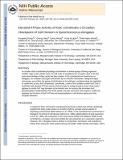Elevated ATPase Activity of KaiC Constitutes a Circadian Checkpoint of Cell Division in Synechococcus elongatus
Author(s)
Dong, Guogang; Yang, Qiong; Wang, Qiang; Kim, Yong-Ick; Wood, Thammajun L.; Osteryoung, Katherine W.; van Oudenaarden, Alexander; Golden, Susan S.; ... Show more Show less
Downloadvan Oudenaarden_Elevated ATPase.pdf (849.5Kb)
OPEN_ACCESS_POLICY
Open Access Policy
Creative Commons Attribution-Noncommercial-Share Alike
Terms of use
Metadata
Show full item recordAbstract
A circadian clock coordinates physiology and behavior in diverse groups of living organisms. Another major cyclic cellular event, the cell cycle, is regulated by the circadian clock in the few cases where linkage of these cycles has been studied. In the cyanobacterium Synechococcus elongatus, the circadian clock gates cell division by an unknown mechanism. Using timelapse microscopy, we confirm the gating of cell division in the wild-type and demonstrate the regulation of cytokinesis by key clock components. Specifically, a state of the oscillator protein KaiC that is associated with elevated ATPase activity closes the gate by acting through a known clock output pathway to inhibit FtsZ ring formation at the division site. An activity that stimulates KaiC phosphorylation independently of the KaiA protein was also uncovered. We propose a model that separates the functions of KaiC ATPase and phosphorylation in cell division gating and other circadian behaviors.
Description
available in PMC 2011 February 1.
Date issued
2010-02Department
Massachusetts Institute of Technology. Department of Mathematics; Massachusetts Institute of Technology. Department of PhysicsJournal
Cell
Publisher
Elsevier B.V.
Citation
Dong, Guogang et al. “Elevated ATPase Activity of KaiC Applies a Circadian Checkpoint on Cell Division in Synechococcus Elongatus.” Cell 140.4 (2010): 529–539. Web.
Version: Author's final manuscript
ISSN
1097-4172
0092-8674